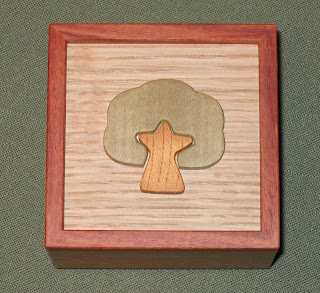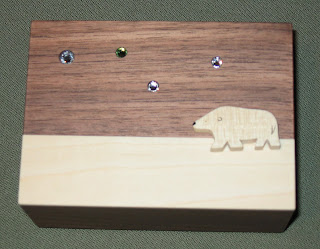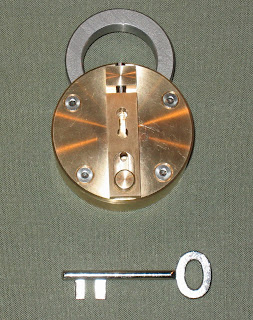Here's a photo of Ken Irvine with Tanya's exchange puzzles. He focused his efforts on getting through some of the burrs which came disassembled. Quite a challenge! In the back corner is Ken's wife, and to the left is Tyler Somer.
Next I decided to check out a few boxes that Jim Strayer brought. The first is the Trinity Knot Box by Jean Claude Constantin (a.k.a. Einstein Box), which I had been wanting to try out since I had seen it appear on the Bits and Pieces website. It didn't look particularly nice, with the telltale look of a laser-cut box. The solution was a commonly used trick, so it is probably not worth getting this box, since there are other boxes with the same mechanism that look better.
Next up I tried an interesting looking little box with a coin sticking up through a slot. It was designed by Jean Claude Constantin and is called Munzbox. This one has a much better appearance than the previous box, with a nice reddish hue and a good finish.
Again, however, this one uses a fairly commonly used mechanism, so most experienced puzzle solvers will figure this one out pretty quickly. Still, this is a fairly nice version of a puzzle with this mechanism.
After that, I decided to try another one of the exchange puzzles that Tanya brought. This one is the Travelling Salesman Puzzle designed and exchanged by Allen Rolfs. It has a nice appearance with a wire man holding a briefcase and a bottle titled "Elixer of Life". All of the pieces are cut out of flat stainless steel, which gives the puzzle a very sturdy feel, though the edges are a bit pointy. The briefcase is actually a flat piece that has been doubled over, so it is hollow in the center all the way up to the part that loops around the man. This allows for some rather interesting movements. You could remove it quite easily if it weren't for that pesky bottle.
I found this one to be fairly challenging since there are plenty of dead-ends that you can wander off on that you can fiddle with for a while before noticing that they don't lead anywhere. Fortunately, the body is symmetrical, so you probably don't have to bother fiddling with both sides. A cute little puzzle that I enjoyed working on.
 Next, on to more puzzle boxes! Here are two boxes that Kelly Snache made and brought, the large one is called The Law of Attraction and the tiny one is called Goliath. As you can see, Goliath is quite small, though it is a fully functional puzzle box! The solution isn't particularly tricky to discover, but there is a nice bit of misdirection and a good "A-ha!" moment when you get it. A fun little puzzle!
Next, on to more puzzle boxes! Here are two boxes that Kelly Snache made and brought, the large one is called The Law of Attraction and the tiny one is called Goliath. As you can see, Goliath is quite small, though it is a fully functional puzzle box! The solution isn't particularly tricky to discover, but there is a nice bit of misdirection and a good "A-ha!" moment when you get it. A fun little puzzle!The Law of Attraction has a fairly similar solution to a number of other boxes, but it implements this solution through a non-traditional means. On top of that, it has a really nice appearance: I really liked the inlay along the edge. It has a generously sized storage compartment too. Here's a photo of Kelly working on one of Eric Fuller's Wunder puzzles that Jeff Chiou lent to me.
Brett's son Kai had brought an interesting variation on the Super Floppy Cube, which I think is called Super Floppy Cube Plus Four, but I'm not sure.
This variation makes the puzzle a bit trickier because the added pieces tend to get in your way, so as you solve one part it tends to mess something else up. Still, it is quite possible to solve on your own without resorting to looking up algorithms online. I really like twisty puzzles that I can actually solve, so this one is good in my book!
Finally, we have a puzzle that Tyler brought called Triple Decker from Bits and Pieces. It was entered in the 2001 Puzzle Design Competition under the name Trinity and was designed by Lynn Yarbrough. I had seen photos of this one before, but didn't quite understand it, so I was glad to have had the opportunity to try it.
There are six rods, with the rods above hooked to the rods below and vice versa. You can see how the bottom rods hook around the two rods on either end of the top in the photo. If you flip it over, it looks exactly the same, so how could it possibly come apart? It seems like each piece is holding another piece in a loop. I spent a good 5 minutes or so fiddling around with this one before I figuring out the solution. It is quite clever! Even thought it is from Bits and Pieces, it actually works fairly well. The slight slop in the fit makes it trickier than it would be otherwise. Definitely worth checking out if you get the chance.
Here's a picture courtesy of Brett with all of the attendees: Jeff Aurand, Ken Irvine and his wife, Jim Strayer, Brett Kuehner, Tyler Somer, Brian Pletcher (me), Tanya's son Brandon, Kelly Snache, Brett's Son Kai, Tanya Thompson, and Brett's wife Denise.
Well, that's all I've got! I had an awesome time at the 2011 Rochester Puzzle Picnic! A big thanks to Jeff for organizing such a fun event, for feeding us and for generally being awesome! Thanks to everybody who brought puzzles, it was a pleasure seeing you all again and I'm already looking forward to the 2012 RPP!








































































